Istanbul's Top Tourist Sites
By Kathy Hamilton
Istanbul’s rich past spans thousands of years and numerous empires, creating a historic mosaic encompassing the city, as well as two continents. With so much to see and explore, it can be overwhelming for the first time visitor to try to decide which sites are ‘must-sees’ in order to have a sampling of Istanbul’s varied past. The top sites on any itinerary should include the following places.
Istanbul’s rich past spans thousands of years and numerous empires, creating a historic mosaic encompassing the city, as well as two continents. With so much to see and explore, it can be overwhelming for the first time visitor to try to decide which sites are ‘must-sees’ in order to have a sampling of Istanbul’s varied past. The top sites on any itinerary should include the following places.
1. Aya Sofia (Hagia Sophia)
This impressive monument to Christianity was erected during the reign of Emperor Justinian (532 - 537 A.D.), when the Byzantine Empire was at the height of its power. The surviving Byzantine mosaics date from the 6th-10th centuries. Converted to a mosque after the conquest of Constantinople, today the church is a museum. Address: Ayasofia Meydani, Sultanahmet.
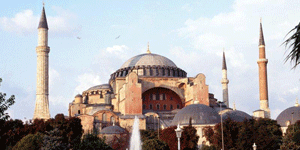
2. Topkapi Palace
Mehmet II began construction of Topkapi Palace shortly after his conquest of Constantinople, and the original buildings were finished in 1465. The palace served as the seat of governance, as well as the sultan’s private living spaces, which included the famed harem. Opened as a museum in 1924, it features unparalleled collections of ceramics, imperial costumes, jewels, miniatures and manuscripts, armor, and religious relics. Address: Babıhümayun Cad., Sultanahmet.
3. Blue Mosque (Sultan Ahmet Camii)
Known for its interior of blue Iznik tiles, the Blue Mosque was built by imperial architect Mehmet Aga in 1609-1616. With over 250 windows in the structure, sunlight floods in, adding to the feeling of space within. Address: Sultanahmet Meydani, Sultanahmet.
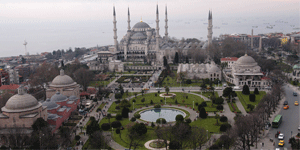
4. Grand Bazaar
In addition to being literally filled to the roof with shops and goods, the Grand Bazaar also boasts restaurants, banks, a post office, a mosque and its own police station. The labyrinths of streets are packed with shops, the merchandise of which spills out into the pathways. Built by Mehmet II after his conquest of the city in 1453, the bazaar is, of course, the place where bargaining is de rigueur. Address: Çarşıkapı Cad., Beyazıt.
5. Basilica Cistern
Built by the Emperor Justinian in 532, the cistern was constructed to supply water to the Great Palace, situated nearby on the Hippodrome. After the conquest of the city by the Ottomans, the cistern went unnoticed until it became apparent that people were lowering buckets through holes in their basements to collect water. Today visitors can explore it along walkways, accompanied by the sounds of dripping water and piped-in classical music. Address: 13 Yerebatan Cad., Sultanahmet.
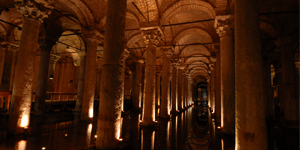
6. Chora Church (Kariye Camii)
Covered with some of the finest Byzantine mosaics and frescoes in the world, the Church of St. Savior in Chora was built during the 11th century. The mosaics depict the genealogy of Christ, the life of the Virgin Mary, the Infancy of Christ and his ministry. The frescoes are thought to have been painted around 1320. Address: Kariye Camii Sokak, Edirnekapi.
7. Galata Tower
Dominating the skyline, Galata Tower was built in 1348 as part of the Genoese fortifications. During Ottoman times it was used as a watch tower, and now the top two floors serve as a restaurant and night club. The panoramic view from the top of the tower includes the main historic sites, and on clear days, the Princes’ Islands are visible out in the Marmara Sea. Address: Büyük Hendel Sokak, Beyoğlu.
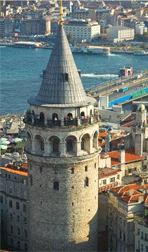
8. Spice Bazaar (Egyptian Bazaar)
Once the pharmacy of the Ottoman Empire, the Spice Bazaar, also called the Egyptian Bazaar, is still an active spice market filled with herbs, spices, honeys, nuts, dried fruits and caviar. Outside of the bazaar, in the courtyard facing the imposing Yeni Mosque, is a thriving horticultural market. Address: Cami Meydani Sokak, Eminönü.
9. Eyup Sultan
Eyüp ranks after Mecca, Medina, and Jerusalem as a major pilgrimage point for Muslims, and is the resting place for Eyüp Ensari, the standard-bearer of the Prophet Muhammed. Falling in battle during the Arab siege of Constantinople in 678 AD, he was buried outside the walls of the city. Leveled by earthquake in 1766, the current structure was built in 1800 by Selim III. Address: Camii Kebir Sokak, Eyüp.
10. Dolmabaçhe Palace
Built in 1856 by Sultan Abdul Mecit, the palace was designed by the Balyan family, a renowned Armenian family of architects. Entry to the palace is by guided tour only, with one tour including the state rooms and Ceremonial Hall. The second tour is of the harem, with the living quarters of the sultan and his family. Atatürk’s bedroom is preserved as it was at the time of his death on November 10, 1938. Address: Dolmabaçhe Cad., Beşiktaş.
ISTANBUL'S TEN MOST OVERLOOKED SITES
After touring the major tourist sites, it is well worth the time to visit these lesser known, but still important, venues to get a better understanding of Istanbul’s past and present. Since most of these are off the main tourist routes, they are much less crowded and offer a more relaxed atmosphere in which to explore on your own and escape from the tour busses clogging other parts of the city.
1. Rüstem Paşa Mosque
This small mosque, built in 1561, is a welcome respite from the frenetic pace of the Spice Bazaar. Designed by Ottoman master architect Sinan for Sultan Süleyman’s son-in-law and Grand Vizier, Rüstem Paşa, this mosque is known for its fantastic array of Iznik tiles. Address: Hasıcılar Cad., Eminönü.
2. Princes’ Islands (Adalar)
Just a 45-minute ferry ride from the city, the Princes’ Islands offer a welcome change of pace from urban life. Justin II was the first to build a palace on Büyükada in 569. During the Byzantine era, the Islands were home to many monasteries, where exiles were often sent. In the second half of the 19th century, the introduction of steamboats made access easier and as a result, wealthy families began to settle there. The easiest way to get there is by the ferries running from Sirkeci or Kabataş.
3. Süleymaniye Mosque
Dominating the Istanbul skyline, the Süleymaniye mosque complex, founded by Sultan Süleyman I, is master architect Sinan’s crowning monument for the city. Construction began in 1550 and took seven years to complete. The largest mosque in the city, the complex at one time included a soup kitchen, guest house, hospital, hamman, and college. The result of his efforts is a mosque that is breathtaking in size, and that has near perfect acoustics. Address: Şifhane Cad., Süleymaniye.
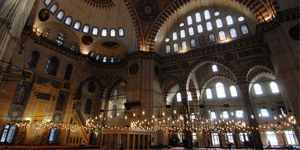
4. Yedikule
Yedikule, the Castle of Seven Towers, was never used as a royal residence, but rather, two of the towers housed foreign envoys who fell out of favor with Ottoman rulers. The original towers were built as part of the Theodosian walls in 390. The top of the walls offer one of the best views to be found in Istanbul. Address: Yedikule Meydani Sokak, Yedikule.
5. Sadberk Hanım Museum
In 1981, the Sadberk Hanım was the first private museum to open in Turkey. Consisting of two large wooden houses on the shores of the Bosphorus, the larger house, built in 1911, was the former summer house of the Koç family. The second building, the Sevgi Gönül Wing, dates from the 20th century. On display are ethnographical items from Turkey, including relics from the Neolithic periods through the Ottoman era. Address: Piyasa Cad. No. 27-29, Büyükdere.
6. Mosaic Museum
The 5th century Great Palace of the Byzantine emperors consisted of hundreds of rooms, many decorated with gold mosaics. The museum is situated on the site of the ancient palace, and the vast floor mosaic is thought to have been in the colonnade between the royal apartments and the imperial enclosure next to the Hippodrome. Address: Arasta Çarşısı, Sultanahmet.
7. Archeological Museum
Housing one of the world’s best collections of antiquities, the museum includes excellent displays of classical and pre-classical treasures. The building itself was constructed by Osman Hamdi Bey (1881-1910) to house his archeological finds, including sarcophagi from Sidon. The new four-story wing opened in 1991 and features exhibits on the history and archeology of Istanbul and surrounding areas, as well as a children’s museum. The Museum of the Ancient Orient features rare and priceless relics from Egyptian and Hittite cultures, as well as from Mesopotamia. The Ishtar Gate dates from 605-562 BC, during the rule of Nebuchadnezzar II in Babylon. Address: Osman Hamdi Bey Yokuşu, Gülhane.
8. Yıldız Park
Originally a part of the grounds of the Çırağan Palace, the garden was later incorporated into the plans of Yildiz Palace, a collection of pavilions and villas built in the 19th and 20th centuries. Spread across the hillside above Ilhamur-Yıldız Boulevard, the palace was at one time the principal residence of Sultan Abdul Hamit II (1876-1909). Address: Çırağan Cad., Beşiktaş.
9. Sabanci Museum
Since 1884, what is today Sabanci Museum has been both a private and royal residence. Opened as the Sabanci University Sakip Sabanci Museum in 2002, it now hosts world-class exhibitions in a state-of-the-art environment. The three ground floors have been preserved as they were when the Sabanci family resided there. The museum also boasts an impressive collection of rare manuscripts as well as an extensive collection of 19th and 20th century paintings. Address: Istinye Cad. No. 22, Emirgan.
10. Turkish and Islamic Art Museum
The former residence of Ibrahim Paşa (1493-1536), Grand Vizier to Sultan Süleyman, the museum hosts a collection dating from the Omayyad Caliphate (661-750) to modern times. With detailed explanations in Turkish and English, each room concentrates on a particular era or region of the Islamic world. The ground floor features displays on the lifestyles of the different Turkic peoples. Address: Atmeydani Sokak, Sultanahmet.
(February 2008, Special Tourism Issue)
This impressive monument to Christianity was erected during the reign of Emperor Justinian (532 - 537 A.D.), when the Byzantine Empire was at the height of its power. The surviving Byzantine mosaics date from the 6th-10th centuries. Converted to a mosque after the conquest of Constantinople, today the church is a museum. Address: Ayasofia Meydani, Sultanahmet.

Hagia Sophia
2. Topkapi Palace
Mehmet II began construction of Topkapi Palace shortly after his conquest of Constantinople, and the original buildings were finished in 1465. The palace served as the seat of governance, as well as the sultan’s private living spaces, which included the famed harem. Opened as a museum in 1924, it features unparalleled collections of ceramics, imperial costumes, jewels, miniatures and manuscripts, armor, and religious relics. Address: Babıhümayun Cad., Sultanahmet.
3. Blue Mosque (Sultan Ahmet Camii)
Known for its interior of blue Iznik tiles, the Blue Mosque was built by imperial architect Mehmet Aga in 1609-1616. With over 250 windows in the structure, sunlight floods in, adding to the feeling of space within. Address: Sultanahmet Meydani, Sultanahmet.

Blue Mosque.
4. Grand Bazaar
In addition to being literally filled to the roof with shops and goods, the Grand Bazaar also boasts restaurants, banks, a post office, a mosque and its own police station. The labyrinths of streets are packed with shops, the merchandise of which spills out into the pathways. Built by Mehmet II after his conquest of the city in 1453, the bazaar is, of course, the place where bargaining is de rigueur. Address: Çarşıkapı Cad., Beyazıt.
5. Basilica Cistern
Built by the Emperor Justinian in 532, the cistern was constructed to supply water to the Great Palace, situated nearby on the Hippodrome. After the conquest of the city by the Ottomans, the cistern went unnoticed until it became apparent that people were lowering buckets through holes in their basements to collect water. Today visitors can explore it along walkways, accompanied by the sounds of dripping water and piped-in classical music. Address: 13 Yerebatan Cad., Sultanahmet.

Basilica Cistern
6. Chora Church (Kariye Camii)
Covered with some of the finest Byzantine mosaics and frescoes in the world, the Church of St. Savior in Chora was built during the 11th century. The mosaics depict the genealogy of Christ, the life of the Virgin Mary, the Infancy of Christ and his ministry. The frescoes are thought to have been painted around 1320. Address: Kariye Camii Sokak, Edirnekapi.
7. Galata Tower
Dominating the skyline, Galata Tower was built in 1348 as part of the Genoese fortifications. During Ottoman times it was used as a watch tower, and now the top two floors serve as a restaurant and night club. The panoramic view from the top of the tower includes the main historic sites, and on clear days, the Princes’ Islands are visible out in the Marmara Sea. Address: Büyük Hendel Sokak, Beyoğlu.

Galata Tower.
8. Spice Bazaar (Egyptian Bazaar)
Once the pharmacy of the Ottoman Empire, the Spice Bazaar, also called the Egyptian Bazaar, is still an active spice market filled with herbs, spices, honeys, nuts, dried fruits and caviar. Outside of the bazaar, in the courtyard facing the imposing Yeni Mosque, is a thriving horticultural market. Address: Cami Meydani Sokak, Eminönü.
9. Eyup Sultan
Eyüp ranks after Mecca, Medina, and Jerusalem as a major pilgrimage point for Muslims, and is the resting place for Eyüp Ensari, the standard-bearer of the Prophet Muhammed. Falling in battle during the Arab siege of Constantinople in 678 AD, he was buried outside the walls of the city. Leveled by earthquake in 1766, the current structure was built in 1800 by Selim III. Address: Camii Kebir Sokak, Eyüp.
10. Dolmabaçhe Palace
Built in 1856 by Sultan Abdul Mecit, the palace was designed by the Balyan family, a renowned Armenian family of architects. Entry to the palace is by guided tour only, with one tour including the state rooms and Ceremonial Hall. The second tour is of the harem, with the living quarters of the sultan and his family. Atatürk’s bedroom is preserved as it was at the time of his death on November 10, 1938. Address: Dolmabaçhe Cad., Beşiktaş.
ISTANBUL'S TEN MOST OVERLOOKED SITES
After touring the major tourist sites, it is well worth the time to visit these lesser known, but still important, venues to get a better understanding of Istanbul’s past and present. Since most of these are off the main tourist routes, they are much less crowded and offer a more relaxed atmosphere in which to explore on your own and escape from the tour busses clogging other parts of the city.
1. Rüstem Paşa Mosque
This small mosque, built in 1561, is a welcome respite from the frenetic pace of the Spice Bazaar. Designed by Ottoman master architect Sinan for Sultan Süleyman’s son-in-law and Grand Vizier, Rüstem Paşa, this mosque is known for its fantastic array of Iznik tiles. Address: Hasıcılar Cad., Eminönü.
2. Princes’ Islands (Adalar)
Just a 45-minute ferry ride from the city, the Princes’ Islands offer a welcome change of pace from urban life. Justin II was the first to build a palace on Büyükada in 569. During the Byzantine era, the Islands were home to many monasteries, where exiles were often sent. In the second half of the 19th century, the introduction of steamboats made access easier and as a result, wealthy families began to settle there. The easiest way to get there is by the ferries running from Sirkeci or Kabataş.
3. Süleymaniye Mosque
Dominating the Istanbul skyline, the Süleymaniye mosque complex, founded by Sultan Süleyman I, is master architect Sinan’s crowning monument for the city. Construction began in 1550 and took seven years to complete. The largest mosque in the city, the complex at one time included a soup kitchen, guest house, hospital, hamman, and college. The result of his efforts is a mosque that is breathtaking in size, and that has near perfect acoustics. Address: Şifhane Cad., Süleymaniye.

Suleymaniye Mosque.
4. Yedikule
Yedikule, the Castle of Seven Towers, was never used as a royal residence, but rather, two of the towers housed foreign envoys who fell out of favor with Ottoman rulers. The original towers were built as part of the Theodosian walls in 390. The top of the walls offer one of the best views to be found in Istanbul. Address: Yedikule Meydani Sokak, Yedikule.
5. Sadberk Hanım Museum
In 1981, the Sadberk Hanım was the first private museum to open in Turkey. Consisting of two large wooden houses on the shores of the Bosphorus, the larger house, built in 1911, was the former summer house of the Koç family. The second building, the Sevgi Gönül Wing, dates from the 20th century. On display are ethnographical items from Turkey, including relics from the Neolithic periods through the Ottoman era. Address: Piyasa Cad. No. 27-29, Büyükdere.
6. Mosaic Museum
The 5th century Great Palace of the Byzantine emperors consisted of hundreds of rooms, many decorated with gold mosaics. The museum is situated on the site of the ancient palace, and the vast floor mosaic is thought to have been in the colonnade between the royal apartments and the imperial enclosure next to the Hippodrome. Address: Arasta Çarşısı, Sultanahmet.
7. Archeological Museum
Housing one of the world’s best collections of antiquities, the museum includes excellent displays of classical and pre-classical treasures. The building itself was constructed by Osman Hamdi Bey (1881-1910) to house his archeological finds, including sarcophagi from Sidon. The new four-story wing opened in 1991 and features exhibits on the history and archeology of Istanbul and surrounding areas, as well as a children’s museum. The Museum of the Ancient Orient features rare and priceless relics from Egyptian and Hittite cultures, as well as from Mesopotamia. The Ishtar Gate dates from 605-562 BC, during the rule of Nebuchadnezzar II in Babylon. Address: Osman Hamdi Bey Yokuşu, Gülhane.
8. Yıldız Park
Originally a part of the grounds of the Çırağan Palace, the garden was later incorporated into the plans of Yildiz Palace, a collection of pavilions and villas built in the 19th and 20th centuries. Spread across the hillside above Ilhamur-Yıldız Boulevard, the palace was at one time the principal residence of Sultan Abdul Hamit II (1876-1909). Address: Çırağan Cad., Beşiktaş.
9. Sabanci Museum
Since 1884, what is today Sabanci Museum has been both a private and royal residence. Opened as the Sabanci University Sakip Sabanci Museum in 2002, it now hosts world-class exhibitions in a state-of-the-art environment. The three ground floors have been preserved as they were when the Sabanci family resided there. The museum also boasts an impressive collection of rare manuscripts as well as an extensive collection of 19th and 20th century paintings. Address: Istinye Cad. No. 22, Emirgan.
10. Turkish and Islamic Art Museum
The former residence of Ibrahim Paşa (1493-1536), Grand Vizier to Sultan Süleyman, the museum hosts a collection dating from the Omayyad Caliphate (661-750) to modern times. With detailed explanations in Turkish and English, each room concentrates on a particular era or region of the Islamic world. The ground floor features displays on the lifestyles of the different Turkic peoples. Address: Atmeydani Sokak, Sultanahmet.
(February 2008, Special Tourism Issue)
Last modified onSaturday, 06 May 2017 10:07
Tagged under
Latest from Admin TOA
- Fat Sal’s Italian Specialties Welcomes Customers in Bayville, NJ with a Renewed Concept
- FFD Wood LLC Delivers Custom Woodwork Solutions from Long Island
- A Tax Expert in the U.S. Tax World: An Interview with Samet Oynamıs
- Announcing the 2025 Edition of the 100 Most Influential Turkish Americans
- CEO Club New York Networking Night Stands Out with the Lamborghini Experience









